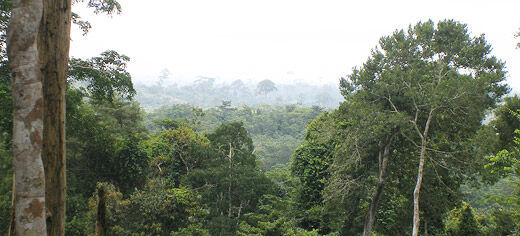
Deforestation in the rainforests of West Africa reduces rainfall over the rest of the forest, according to new University of Leeds research published in Geophysical Research Letters.
The study shows that changing land use from forest to crop land reduces rainfall over neighbouring trees by around 50% due to changes in the surface temperature which affects the formation of rain clouds.
The authors say the findings have important implications for future decisions about land management in this region and other global rainforests such as the Amazon.
Lead author of the study Dr Luis Garcia-Carreras, from the University of Leeds School of Earth and Environment, said: "We already know from satellite observations that changes in land use can have a big impact on local weather patterns. Here we have been able to show why this happens.
"Our findings suggest that it's not just the number of trees removed that threatens the stability of the world's rainforests, the pattern of deforestation is also important."
The forests of West Africa and the Congo Basin are the second largest in the world after the Amazon rainforest. They are important not only as a habitat for a vast and diverse ecosystem but also as a carbon sink, removing a large proportion of the CO2 in the Earth's atmosphere and slowing down climate change.
For many years deforestation has been occurring widely in Africa, with tree canopies being removed in favour of agriculture, plantations and other non-forest uses.
While the direct removal of trees has an immediate impact on the forest, this new study suggests that there also may be a secondary effect caused by the reduced rainfall.
"African rainforests already have the lowest rainfall of any rainforest ecosystem on Earth, which could make them particularly sensitive to changes in local weather patterns," said Dr Garcia-Carreras.
"Therefore if rainfall is reduced even further as a result of deforestation, it could threaten the survival of the remaining forest by increasing the trees' sensitivity to drought."
To investigate the effects of different vegetation on locally-produced rain in West Africa, the researchers used a Met Office computer model to simulate rainfall under different land-use conditions.
They found that while the total amount of precipitation was largely unaffected, rainfall was four to six times higher over warm areas (cropland) than when no deforestation has occurred, while rainfall over the remaining forest was half or less.
The difference in rainfall is caused by the temperature change between cropland and forest, which produces winds that converge over the crop area and form clouds.
Study co-author Professor Doug Parker, also from the University of Leeds, added: "While our study only focussed on a small region in Africa, it's reasonable to suggest that this mechanism could be common in other global forests based on similar observations of rainfall in Amazonia."
"This has implications for planners in terms of how deforestation is managed. If forest must be removed to create cropland, we need to think about what are the shapes and distributions of deforestation that will be least damaging to the adjacent forests and national parks."
The research was funded by the Natural Environment Research Council as part of the international African Monsoon Multidisciplinary Analysis (AMMA).
Further information:
Contact: University of Leeds Communications & Press Office; Tel: 0113 343 4031; Email: pressoffice@leeds.ac.uk
The paper entitled: 'How does local tropical deforestation affect rainfall' by L Garcia-Carreras and Douglas J Parker is published in Geophysical Research Letters (doi:10.1029/2011GL049099).